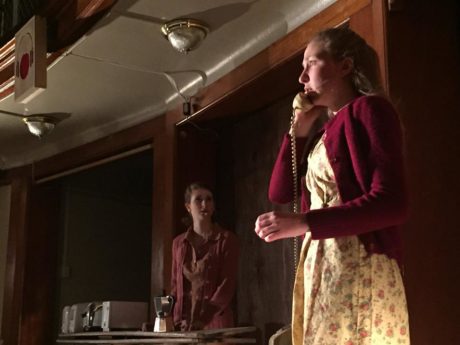Seeing an Acme Corporation show is like attending a graduate class for which you never got the reading list, but still have to take the exam. Those who have studied theater academically will get a lot from Acme Corporation’s latest production, Follow No Strangers To the Fun Places. I studied journalism and art history in college. I missed a lot during the performance, even though I have seen and performed in a lot of theater. Acme’s show is next-level stuff. And it’s brilliant. (I still got a lot out of it, even though I felt less-than-brilliant watching it.)

Acme says in its press release that Follow No Strangers is loosely inspired by the structure of Italo Calvino’s 1979 postmodern novel, If on a winter’s night a traveler, which focuses on the act of reading. (I have never read Italo Calvino, and completely missed this reference. But, don’t worry, you do not need to have read his book. Just know Acme’s artists are mad smart, thoughtful, and well-read.)
Lola B. Pierson’s script instead deconstructs the audience’s experience of watching theater, as well as the theater-makers’ perspective of creating theater. Side note: Pierson has a bachelor’s in human rights and playwriting from Bard College and a master’s in theatre arts from Towson University. She’s wicked smart.
Co-artistic Directors Pierson and Stephen Nunns also co-direct the show. The first time I met Nunns, a theater professor at Towson, he told me he had been a theater critic, but got burned out reviewing bad theater. He wanted to focus instead on being on the other side of the fourth wall, and make (good) theater. What he and Pierson have created with Follow No Strangers is very good theater, which expertly dives deep into the creation and consumption of the art form.
Follow No Strangers is a series of scenes that attempt to make several different pieces of theater. These short scenes are interrupted by interludes with the two theater-making characters, who have their own personal drama apart from what they are trying to present on stage. Acme’s press release explains: “Through constant breaks, disruptions and disconnections, the show breaks down theatrical narrative; explores the relation of fiction to real life; and ultimately tries to answer the question of why anyone would want to make art in the first place.”
The show succeeds in breaking down theatrical narrative and devices, but it’s sometimes difficult to fully “get” what those devices are because of the fast pace of the show and richness of the other production elements. (Even for someone who was fastidiously taking notes throughout the show.)

The show is multimedia heavy. Each audience member has headphones, and two headphone-shaped lights above the stage—one green, one red—instruct when to put them on and take them off. The stage is covered in what seem to be pages of a script, and partway through the show, a large rectangular x-ray-like lightbox covered in pieces of paper is propped against the back wall.
On the stage are more x-ray-like light boxes—here showing ribs, a hand, a bee. So much symbolism! Oh, I have to put my headphones back on? Wait, and unwrap a box and check off words that were introduced to the Webster Dictionary in 1956 that speak to me? Ah! I’m missing so much! What is the actor on stage saying?
Acme ensures that there is no lagging in this show. You must pay attention to have any meaningful experience with the piece. You can’t just sit and be spoon-fed a story. The experience of seeing Follow No Stranger takes work. In addition to a graduate class, it’s also kind of like going to a modern art museum—complete with an artsy video on a small, old TV set of a woman having a one-sided phone conversation while another voice says the same lines over her through your headphones. The spectator decides what it’s all supposed to mean, or not mean.
Acme is actually a little like performance art in that way. It’s interpretative, but its creators, you just know, have given the art a lot of thought. Similarly, a Rothko painting in quick passing could just look like swaths of paint, or with more information and more thoughtfulness, it could reflect emotional content informed by Nietzsche, Greek mythology, and the artist’s Russian-Jewish heritage (that last part is from The Art Story).
In addition to the aforementioned “The Telephone Call,” there are seven other small scenes in Follow no strangers, each intriguing. “Follow No Strangers to All the Fun Places” starts off the parade of narratives with three women dressed in 1930s-ish house-wife outfits and a man stumbling on stage in a blood-stained shirt. Just when you’re ready to take in this story, a voice over starts commenting on stage directions and artistic choices.
Then, “Thing 2” actor Kaya Vision comes on stage wearing an arm sling like Nunns was as he greeted guests, and says he had shoulder surgery (as Nunns did when I asked him before the show what had happened to his arm). After the show, my date says she thought it was funny how Vision and “Thing 1” actor Christy Kato Czajkowski talked about casting themselves with more-attractive actors to play them in a show, and that Vision and Czajkowski were representations of Nunns and Pierson. (I did not totally understand that while watching the show). The more knowledge of theater, Acme Corporation, and Baltimore small theater you have (there’s a reference to Single Carrot’s current production, Peter Pan), the more you will take from Follow No Strangers.
All of the actors seem completely aware of the intentions of their multiple characters and of their writer and directors. In addition to Vision and Czajkowski, the excellent cast includes Naomi Kline, Chris Ashworth, Kristina Szilagyi, Molly Cohen, John Kern, Caelyn Sommerville and Deirdre McAllister.
The rest of the artistic team presents equally thoughtful work. Eric Nightengale creates a moody, appropriately dramatic lighting design, and Brent Tomchik’s sound design adds another layer with original music by Drew Swinburne, Dan Deacon, and Nunns. Actor Molly Cohen doubles as costumer, and Writer/Co-Director/Co-Artistic Director Pierson quadruples as set designer. Myles Poland is responsible for those symbolic x-ray light boxes.
Follow No Strangers to the Fun Places is a show for theater-goers and theater-makers. It is overwhelming at times but is an overall excellent production.
Running Time: Approximately one hour with no intermission.
Follow No Strangers to the Fun Places plays through May 19, 2018, at The Great Hall at St. Mark’s Lutheran Church – 1900 St. Paul Street, in Baltimore, MD. For tickets, but them at the door, or purchase them online.




